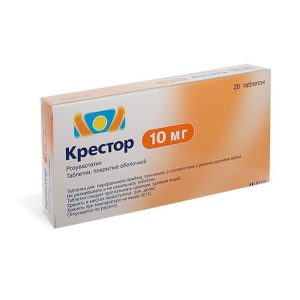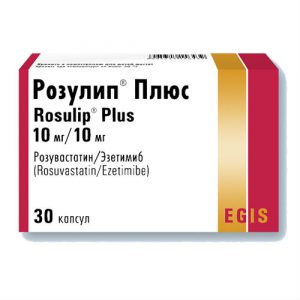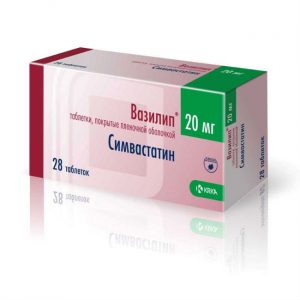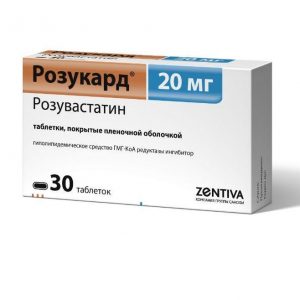Description
Packing
30 pcs
Indications
– Primary hypercholesterolemia according to Fredrickson (type IIa, including familial heterozygous hypercholesterolemia) or mixed hypercholesterolemia (type IIb) as a supplement to the diet, when diet and other non-drug treatments (e.g., exercise, weight loss) are inadequate.
– Family homozygous hypercholesterolemia as a supplement to diet and other lipid lowering therapy (e.g., LDL apheresis), or in cases where such therapy is not effective enough.
– Hypertriglyceridemia (type IV according to Fredrickson) as a supplement to the diet.
– Primary dysbetalipoproteinemia (type III according to Frederickson) as a supplement to the diet.
– To slow the progression of atherosclerosis as a supplement to the diet in patients who are shown therapy to reduce the concentration of total cholesterol and LDL-C.
– Primary prophylaxis of major cardiovascular complications (stroke, heart attack, arterial revascularization) in adult patients without clinical signs of coronary artery disease, but with an increased risk of its development (over 50 years old for men and over 60 years old for women, increased concentration of C-reactive protein ( 2 mg / l) in the presence of at least one of the additional risk factors, such as arterial hypertension, low concentration of HDL-C, smoking, family history of early onset of coronary heart disease).
Contraindications
For the rosuvastatin-SZ drug in a daily dose of 5 mg, 10 mg and 20 mg:
– hypersensitivity to rosuvastatin or any of the components of the
preparation – lactose intolerance, lactase deficiency or glucose-glucose glucose-glucose glucose preparation )
– children under the age of 18
– liver disease in the active phase, including a persistent increase in serum transaminase activity and any increase in serum transaminase activity (more than 3 times compared with the upper limit of normal we)
– severe renal failure (CC less than 30 ml / min. )
– myopathy
– simultaneous administration of cyclosporine
– in women: pregnancy, breastfeeding, lack of adequate methods of contraception
– increase in the concentration of creatine phosphokinase (CPK) in the blood by more than 5 times compared with the upper limit of normal
– joint use with inhibitor
HIV protease – for patients predisposed to the development of myotoxic complications
For the daily dose of rosuvastatin-SZ 40 mg:
– hypersensitivity to rosuvastatin or any of the components of the drug s rdlkp – lactose intolerance, lactase deficiency or glucose-galactose malabsorption (the drug contains lactose)
– children under 18 years of age
– concurrent use of cyclosporine
– in women: pregnancy, period of breastfeeding, the lack of adequate methods of contraception
– an increase in the concentration of creatine phosphokinase (CPK) in the blood by more than 5 times compared with the upper limit of normal
– combined use with HIV protease inhibitors
– moderate and severe renal failure (CC less than 60 ml / min. )
– liver disease in the active phase, including a persistent increase in serum transaminase activity and any increase in serum transaminase activity (more than 3 times compared with the upper limit of normal) for patients with risk factors Vitality of myopathy / rhabdomyolysis, namely:
– hypothyroidism
– myotoxicity while taking other HMG-CoA reductase inhibitors or fibrates in the history of
– excessive alcohol consumption
– condition, which can lead to an increase in the plasma concentration of rosuvastatin
– concomitant use of
fibrates – myopathy
– personal or family history of muscle diseases
– for patients of the Mongoloid race
Caution
For rosuvastatin-10 mg 10 mg daily: The presence of a risk of developing myopathy / rhabdomyolysis – renal failure, hypothyroidism, a personal or family history of hereditary muscle diseases and a previous history of muscle toxicity when using other HMG-Co inhibitors A-reductase or fibrate excessive alcohol consumption age over 65 years of age conditions in which there is an increase in the plasma concentration of rosuvastatin race (Mongoloid race) concurrent administration with fibrates (see section Pharmacokinetics ) a history of liver disease sepsis arterial hypotension extensive surgery, trauma, severe metabolic, endocrine or electrolyte disturbances or uncontrolled seizures. Concomitant use with colchicine and with ezetimibe (see section “Interaction with other drugs”). For the daily dose of rosuvastatin-SZ 40 mg: Renal insufficiency of mild severity (CC more than 60 ml / min) age over 65 years of liver disease in the history of sepsis arterial hypotension extensive surgery, trauma, severe metabolic, endocrine or electrolyte disturbances or uncontrolled convulsive seizures. Concomitant use with colchicine and with ezetimibe (see section “Interaction with other drugs”). Patients with liver failure There is no data or experience with the use of the drug in patients with more than 9 Child-Pugh scores (see the sections Pharmacodynamics and Special Instructions ).
Use during pregnancy and lactation
Rosuvastatin-SZ is contraindicated in pregnancy and during breastfeeding. Women of reproductive age should use adequate methods of contraception. Since cholesterol and other cholesterol biosynthesis products are important for fetal development, the potential risk of inhibiting HMG-CoA reductase exceeds the benefit of using the drug in pregnant women. In case of pregnancy during treatment, the drug should be stopped immediately. Data on the allocation of rosuvastatin with breast milk are not available, therefore, during the period of breastfeeding, the drug should be discontinued (see section “Contraindications”).
Composition
Active ingredient: rosuvastatin calcium in terms of rosuvastatin – 5 mg.
Excipients: core – lactose monohydrate (milk sugar) – 32.9 mg of calcium hydrogen phosphate dihydrate – 5.0 mg of povidone (polyvinylpyrrolidone medium molecular weight) – 3.0 mg of croscarmellose sodium (primellose) – 3.0 mg of sodium stearylfumarate – 0.8 mg silicon dioxide colloidal (aerosil) – 0.3 mg microcrystalline cellulose – 30.0 mg shell – Opadry II (polyvinyl alcohol, partially hydrolyzed – 0.88 mg macrogol (polyethylene glycol) 3350 – 0.247 mg talc – 0.4 mg titanium dioxide E 171 – 0.3834 mg soya lecithin E 322 – 0.07 mg indigo carmine dye based varnish – 0.0012 m g aluminum varnish based on the dye azorubine – 0.0102 mg aluminum varnish based on the dye crimson [Ponceau 4R] – 0.0082 mg).
Dosage and Administration
Inside, do not chew or grind the tablet, swallow whole, washed down with water. The drug can be prescribed at any time of the day, regardless of food intake. Before starting therapy with Rosuvastatin-S3, the patient should begin to follow a standard hypocholesterolemic diet and continue to follow it during treatment. The dose of the drug should be selected individually depending on the goals of therapy and the therapeutic response to treatment, taking into account current recommendations on target lipid concentrations. The recommended starting dose for patients starting to take the drug, or for patients transferred from taking other HMG-CoA reductase inhibitors, should be 5 mg or 10 mg of the drug Rosuvastatin-SZ 1 time per day. When choosing an initial dose, one should be guided by the individual cholesterol content and take into account the possible risk of cardiovascular complications, and it is also necessary to assess the potential risk of side effects. If necessary, the dose can be increased to a larger after 4 weeks (see section “Pharmacodynamics”). Due to the possible development of side effects when taking a dose of 40 mg, compared with lower doses of the drug (see section Side effects ), increasing the dose to 40 mg after an additional dose is higher than the recommended initial dose for 4 weeks therapy can be carried out only in patients with severe hypercholesterolemia and a high risk of cardiovascular complications (especially in patients with familial hypercholesterolemia), who have not achieved the desired result of therapy when taking a dose of 20 mg, and which will be under the supervision of a specialist (see section “Special instructions”). Particularly careful monitoring of patients receiving the drug at a dose of 40 mg is recommended. A dosage of 40 mg is not recommended for patients who have not previously consulted a doctor. After 2-4 weeks of therapy and / or with an increase in the dose of the drug Rosuvastatin-SZ, monitoring of lipid metabolism is necessary (dose adjustment is necessary if necessary).
Homozygous hereditary hypercholesterolemia
Recommended starting dose is 20 mg once daily.
Elderly patients
Patients over the age of 65 are advised to start using the drug with a dose of 5 mg once a day.
Patients with renal failure
Dose adjustment is not required in patients with mild or moderate renal failure.
In patients with severe renal failure (CC less than 30 ml / min.), the use of the drug Rosuvastatin-SZ is contraindicated. The use of the drug in a dose of 40 mg is contraindicated in patients with moderate impaired renal function (CC 30-60 ml / min.) (See sections “Special Instructions” and “Pharmacodynamics”). For patients with moderate impaired renal function, an initial dose of 5 mg is recommended.
Patients with liver failure
Rosuvastatin-S3 is contraindicated in patients with active liver disease (see section “Contraindications”).
Special Populations.
Ethnic groups In the study of the pharmacokinetic parameters of rosuvastatin in patients belonging to different ethnic groups, an increase in the systemic concentration of rosuvastatin among Japanese and Chinese was noted (see the section “Special Instructions”). This fact should be taken into account when prescribing Rosuvastatin-SZ to these patient groups. When prescribing doses of 10 mg and 20 mg, the recommended initial dose for patients of the Mongoloid race is 5 mg. The administration of the drug in a dose of 40 mg is contraindicated for patients of the Mongoloid race (see section “Contraindications”).
Patients predisposed to myopathy
Administration of the drug in a dose of 40 mg is contraindicated in patients with factors that may indicate a predisposition to the development of myopathy (see section “Contraindications”). When prescribing doses of 10 mg and 20 mg, the recommended initial dose for this group of patients is 5 mg (see section “Contraindications”).
Use with concomitant therapy
With the simultaneous use of the drug with gemfibrozil, fibrates, nicotinic acid in a dose of more than 1 g / day, an initial dose of 5 mg is recommended for patients. The dose of the drug Rosuvastatin-SZ should not exceed 10 mg once a day.
Side effects
Side effects observed when taking Rosuvastatin-SZ are usually mild and go away on their own. As with other HMG-CoA reductase inhibitors, the incidence of side effects is mainly dose-dependent. The frequency of occurrence of undesirable effects is presented as follows: often (> 1 / 100.1 / 1000.1 / 10000, <1/1000) is very rare (<1/10000), the frequency is unknown (according to the available data, it is not possible to establish the frequency of occurrence) including individual messages. immune system Rarely: hypersensitivity reactions, including angioedema. Endocrine system Often: type 2 diabetes mellitus From the central nervous system Often: headache, dizziness From the digestive tract Often: constipation, nausea, abdominal pain Rarely: pancreatitis From the side : pruritus, rash, urticaria From the musculoskeletal system Often: myalgia Rarely: myopathy (including myositis), rhabdomyolysis Other Often: asthenic syndrome From the urinary system In patients treated with Rosa SZ, proteinuria can be detected. Changes in the amount of protein in the urine (from the absence or trace amounts to ++ or more) are observed in less than 1% of patients receiving 10 to 20 mg of the drug, and in approximately 3% of patients receiving 40 mg of the drug. A slight change in the amount of protein in the urine was observed when taking a dose of 20 mg. In most cases, proteinuria decreases or disappears during therapy and does not mean the occurrence of acute or progression of an existing kidney disease. From the musculoskeletal system The following effects on the musculoskeletal system: myalgia, myopathy (including myositis), in rare cases, have been reported with the use of the drug Rosuvastatin-SZ in all doses, and especially when taking doses of the drug in excess of 20 mg cases – rhabdomyolysis with acute renal failure or without it. A dose-dependent increase in the activity of creatine phosphokinase (CPK) is observed in a small number of patients taking rosuvastatin. In most cases, it was mild, asymptomatic and temporary. In case of increased activity of CPK (more than 5 times compared with the upper limit of normal), therapy should be suspended (see section “Special instructions”). On the part of the liver When using rosuvastatin, a dose-dependent increase in the activity of liver transaminases is observed in a small number of patients. In most cases, it is insignificant, asymptomatic and temporary. Laboratory indicators When using the drug Rosuvastatin-SZ, the following changes in laboratory parameters were also observed: an increase in the concentration of glucose, bilirubin, the activity of gamma-glutamyl transpeptidase, alkaline phosphatase, and dysfunction of the thyroid gland. Post-marketing use of The following side effects have been reported in the post-marketing use of the drug Rosuvastatin-SZ: From the digestive tract Very rare: jaundice, hepatitis Rarely: increased activity of liver transaminases. Frequency unknown: diarrhea, fatal and non-fatal liver failure From the musculoskeletal system Very rare: arthralgia. Frequency unknown: Immuno-mediated necrotizing myopathy From the central nervous system Very rare: polyneuropathy, forgetfulness, amnesia, memory loss, confusion From the respiratory system Frequency unknown: cough, shortness of breath From the urinary system Very rarely: From the skin and subcutaneous fat Frequency unknown: Stevens-Johnson syndrome From the reproductive system and mammary gland Frequency unknown: gynecomastia Other Frequency unknown: peripheral edema thrombocytopenia interstitial lung disease. The following side effects have been reported with some statins: depression, sleep disturbances, including insomnia and nightmares, sexual dysfunction. Drug interaction Cyclosporine and gemfibrozil potentiate the effects of rosuvastatin. Antacids containing magnesium or aluminum reduce the plasma concentration of rosuvastatin by about 50% (they should be taken 2 hours after taking rosuvastatin). Erythromycin, by enhancing gastrointestinal motility, reduces the effects of rosuvastatin. Rosuvastatin enhances the effects of oral contraceptives. Gemfibrozil, other fibrates, and nicotinic acid in lipid-lowering doses (approximately 1 g / day) increase the possibility of myopathy when used together with rosuvastatin. Co-administration of rosuvastatin with itraconazole increases 28% of rosuvastatin AUC (clinically insignificant). When combined with rosuvastatin with drugs that reduce the content of endogenous steroid hormones (including cimetidine, ketoconazole, spironolactone), a more pronounced decrease in endogenous steroid hormones is possible. Overdose When co-administered with multiple daily doses, the pharmacokinetic parameters of rosuvastatin do not change. There is no specific treatment for overdose with rosuvastatin. In case of overdose, it is recommended to carry out symptomatic treatment and measures aimed at maintaining the functions of vital organs and systems. Control of liver function and CPF level is required. Hemodialysis is unlikely to be effective. Storage conditions Store in a dry, dark place at a temperature not exceeding 30 ° C. Expiration 3 years. Do not use after the expiry date stated on the packaging. Deystvuyuschee substances rosuvastatin Pharmacy terms Prescription Dosage form Dosage form Tablets Northern Star, Russia




